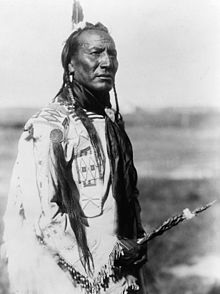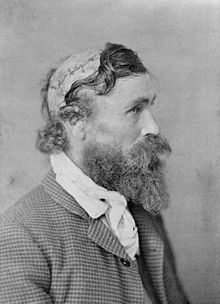Scalping

Scalping is the act of removing the scalp, usually with the hair. It can be applied to a dead body, or on someone alive, in which case it may or may not be deadly.
Scalping is applied to provide a portable proof or trophy of prowess in war. Scalping is also associated with frontier warfare in North America, and was practiced by Native Americans, colonists, and frontiersmen over centuries of violent conflict. William Brandon, a Native American specialist, has stated that some Mexican (e.g. Sonora and Chihuahua) and American states (e.g. Arizona) paid bounty for enemy Native American scalps.[1] Contrary to formerly popular beliefs, scalping was far from universal amongst Native Americans.[2]
Scythia
Scalping was practiced by the ancient Scythians of Eurasia. Herodotus, the Greek historian, wrote of the Scythians in 440 BC: "The Scythian soldier scrapes the scalp clean of flesh and softening it by rubbing between the hands, uses it thenceforth as a napkin. Scyths helped the scalper confess his love for her. The Scyth is proud of these scalps and hangs them from his bridle rein; the greater the number of such napkins that a man can show, the more highly is he esteemed among them. Many make themselves cloaks by sewing a quantity of these scalps together."
Western Europe
Scalps were taken in wars between the Visigoths, the Franks and the Anglo-Saxons in the 9th century according to the writings of Abbé Emmanuel H. D. Domenech. His sources included the decalvare of the ancient Germans, the capillos et cutem detrahere of the code of the Visigoths, and the Annals of Flodoard.
North America



According to ethnohistorian James Axtell, there is abundant evidence that the Native American practice of scalping existed long before Europeans arrived. Axtell argues that there is no evidence that the early European explorers and settlers who came to the Americas were familiar with the ancient European practice of scalping, or that they ever taught scalping to Native Americans. Axtell writes that the idea that Europeans taught scalping to Native Americans became popular recently, during the 1960s. This idea quickly became conventional wisdom because it fit the tenor of the times of the counter-cultural 1960s, writes Axtell, but he argues that archaeological, historical, pictorial, and linguistic evidence contradicts this notion. Certain tribes of Native Americans practiced scalping, in some instances up until the 19th century.[citation needed]
The standard Native American technique for scalping was to place a knee between the shoulders while the body was on the ground, to cut a long arc in the front of the scalp, and then to pull back on the hair. If the person survived, the person's facial features drooped.[citation needed] Women would sometimes make a tight braid to pull the skin back up.[citation needed]
Both Native Americans and American frontiersmen frequently scalped their victims in this era. Some[who?] believe that contact with Europeans widened the practice of scalping among Native Americans, since some Euro-American governments encouraged the practice among their Native American allies by offering bounties for scalps during times of war.
Examples of the payment for scalps are those issued by the government of Massachusetts in 1744 for the scalps of Indian men, women, and children; Governor Edward Cornwallis' proclamation of 1749 to settlers of Halifax of payment for Indian scalps; and French colonists in 1749 offering payments to Indians for the scalps of British soldiers.[citation needed]
In the Revolutionary War, Henry Hamilton, the British lieutenant-governor of Province of Quebec (1763-1791), was known by American Patriots as the "hair-buyer general" because they believed he encouraged and paid his Native American allies to scalp American settlers. When Hamilton was captured in the war by the colonists, he was treated as a war criminal instead of a prisoner of war because of this. However, American historians have conceded that there was no positive proof that he had ever offered rewards for scalps.[4] It is now assumed that during the American Revolution, no British officer paid for scalps.[5]
Famously, General Custer supposedly was not scalped after the Battle of Little Big Horn because he was deemed filthy in the eyes of the Sioux - to lay hands on him would sully the hands of the warrior. But more likely Custer was not scalped due to his hair making a poor scalp, Custer having his famous locks shorn rather closely before the campaign, plus his receding hairline.
In Canada, a 1756 British proclamation issued by Governor Charles Lawrence offering a reward for scalps has yet to be officially repealed, although it is not in effect anymore.[6]
In motion pictures, popular literature, and entertainment
The act of scalping featured prominently in some Westerns such as the 1966 Burt Reynolds spaghetti western Navajo Joe which opens with an Indian massacre in which a white profiteer scalps an Indian woman, and the 1990 film Dances with Wolves which shows Pawnee Indians with scalps hanging from their bow or lance. The Cormac McCarthy novel Blood Meridian is about a group of mercenaries making a living off of Indian scalps and references the activity extensively, and in Karl May's novels' the character Sam Hawkins had been scalped by Indian warriors and survives. The first work in the Lonesome Dove series, Dead Man's Walk features a scalping, and George Macdonald Fraser's antihero, Harry Flashman, observes scalping and is himself partially scalped in Flashman and the Redskins.
Stories that are not strictly Westerns but feature Native American characters or themes also deal with the practice. For example, the 1992 film The Last of the Mohicans based on the novel by James Fenimore Cooper shows many acts of scalping throughout the film, notably in the battle-scenes between the Native Americans and the European troops. In the 1994 film Legends of the Fall Tristan Ludlow (Brad Pitt) scalps many German soldiers in the First World War resulting in his discharge from army service.
The horror genre uses scalping as a violent and sensationalist act. Examples include the 2002 film Deathwatch where Pvt. Thomas Quinn (Andy Serkis) wears a vest made from German scalps and is seen scalping an executed prisoner in one scene, the 2009 World War II film Inglourious Basterds where American irregulars collect scalps of killed Wehrmacht servicemen, with orders from their commanding officer to collect 100 scalps each, the 2007 film Saw IV where a woman named Brenda is put into a scalping chair torture device, and the video game Gun where the player is able to scalp dying enemies after purchasing a special scalping knife.
See also
Notes
- ^ The American Heritage Book of Indians (1961), by William Brandon
- ^ World of the American Indian, by Jules B. Billard, National Geographic Society; First Printing edition (1974), Washington DC
- ^ [1]
- ^ Dictionary of Canadian Biography Online: Henry Hamilton
- ^ Kelsey pg. 303
- ^ British Scalp Proclamation: 1756
References
- Kelsey, Isabel, Joseph Brant 1743-1807 Man of Two Worlds, 1984, ISBN 0-8156-0182-4
- Axtell, James. "Scalps and Scalping" from Encyclopedia of North American Indians
- Dictionary of Canadian Biography Online: Henry Hamilton
